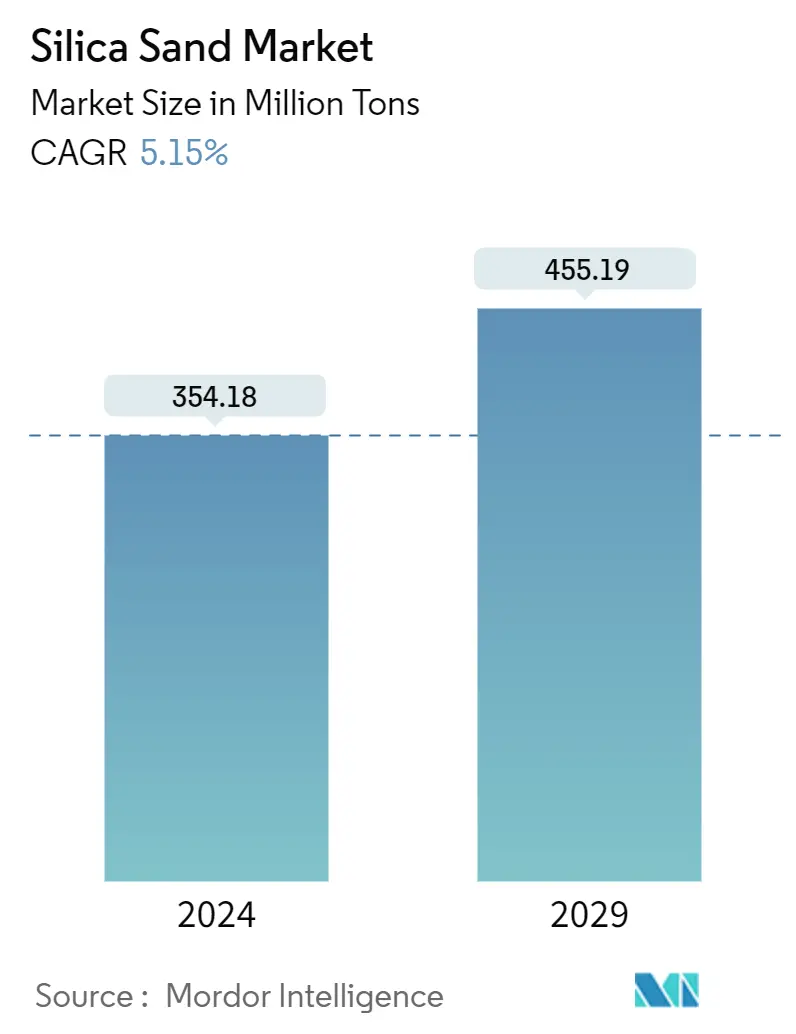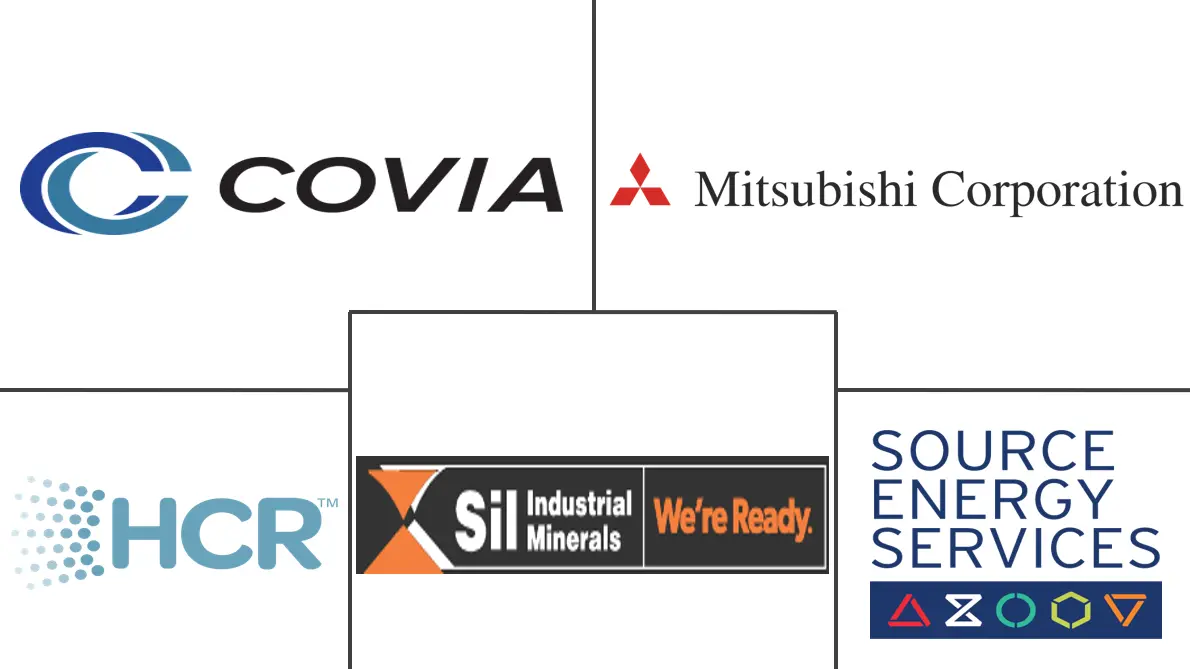Market Size of Silica Sand Industry

| Study Period | 2019-2029 |
| Base Year For Estimation | 2023 |
| CAGR (2024 - 2029) | 5.15 % |
| Fastest Growing Market | Asia Pacific |
| Largest Market | Asia Pacific |
| Market Concentration | High |
Major Players
*Disclaimer: Major Players sorted in no particular order |
Silica Sand Market Analysis
The Silica Sand Market size is estimated at 354.18 Million tons in 2024, and is expected to reach 455.19 Million tons by 2029, growing at a CAGR of 5.15% during the forecast period (2024-2029).
The market was negatively impacted due to COVID-19. Owing to the pandemic, several countries worldwide went into lockdown to curb the spread of the virus. The shutdown of numerous companies and factories has disrupted worldwide supply networks and harmed global production, delivery schedules, and product sales. Currently, the market has recovered from the COVID-19 pandemic and increasing at a significant rate.
- Over the medium term, the major factors driving the market growth are the increasing demand from the foundry industry and the growing demand from the glass industry.
- On the flip side, the availability of substitutes and concerns over the environmental impacts of silica sand mining is likely to restrain the market growth.
- The growing water treatment industry is likely to act as an opportunity for the market in the coming years.
- Asia-Pacific accounted for the highest market share, and the region is likely to dominate the market during the forecast period.
Silica Sand Industry Segmentation
Silica sand is a type of sand with high silicon dioxide (SiO2) content. It is a naturally occurring material that is found in many parts of the world. Silica sand is used in a variety of applications, including glassmaking, foundries, and fracking, among others.
The silica sand market is segmented by end-user industry and geography. By end-user industry, the market is segmented into glass manufacturing, foundry, chemical production, construction, paints and coatings, ceramics and refractories, filtration, oil and gas, and other end-user industries. The report also covers the market size and forecasts for the silica sand market in 15 countries across major regions. For each segment, market sizing and forecasts are done in volume (tons).
| End-user Industry | |
| Glass Manufacturing | |
| Foundry | |
| Chemical Production | |
| Construction | |
| Paints and Coatings | |
| Ceramics and Refractories | |
| Filtration | |
| Oil and Gas | |
| Other End-user Industries |
| Geography | |||||||
| |||||||
| |||||||
| |||||||
| |||||||
|
Silica Sand Market Size Summary
The silica sand market is poised for significant growth over the forecast period, driven by increasing demand from the foundry and glass industries. The market has shown resilience and recovery post-COVID-19 disruptions, which had previously impacted global supply chains and production schedules. The Asia-Pacific region, particularly China and India, is expected to dominate the market due to its robust industrial activities and expanding oil and gas sector. The region's growth is further supported by the burgeoning glass manufacturing industry, which is witnessing increased adoption in construction and automotive sectors. However, the market faces challenges from the availability of substitutes and environmental concerns related to silica sand mining.
In the oil and gas industry, silica sand, known as frac sand, plays a crucial role in hydraulic fracturing processes, enhancing oil flow rates by keeping fractures open in shale formations. The anticipated rise in global oil demand, particularly from China and India, is expected to bolster the market for silica sand, as these countries continue to expand their refining capacities and explore unconventional crude oil reserves. The market is characterized by a consolidated structure, with key players like Hi-Crush Inc., Covia Holdings LLC, and Mitsubishi Corporation actively engaging in strategic acquisitions and partnerships to enhance production capabilities. Despite potential environmental concerns, the growing water treatment industry presents new opportunities for market expansion.
Silica Sand Market Size - Table of Contents
-
1. MARKET DYNAMICS
-
1.1 Drivers
-
1.1.1 Increasing Demand from the Foundry Industry
-
1.1.2 Growing Demand from the Glass Industry
-
-
1.2 Restraints
-
1.2.1 Availability of Substitutes
-
1.2.2 Illegal Mining of Sand
-
1.2.3 Concerns over Environmental Impacts of Silica Sand Mining
-
-
1.3 Industry Value Chain Analysis
-
1.4 Porter Five Forces
-
1.4.1 Bargaining Power of Suppliers
-
1.4.2 Bargaining Power of Consumers
-
1.4.3 Threat of New Entrants
-
1.4.4 Threat of Substitute Products and Services
-
1.4.5 Degree of Competition
-
-
-
2. MARKET SEGMENTATION (Market Size in Volume)
-
2.1 End-user Industry
-
2.1.1 Glass Manufacturing
-
2.1.2 Foundry
-
2.1.3 Chemical Production
-
2.1.4 Construction
-
2.1.5 Paints and Coatings
-
2.1.6 Ceramics and Refractories
-
2.1.7 Filtration
-
2.1.8 Oil and Gas
-
2.1.9 Other End-user Industries
-
-
2.2 Geography
-
2.2.1 Asia-Pacific
-
2.2.1.1 China
-
2.2.1.2 India
-
2.2.1.3 Japan
-
2.2.1.4 South Korea
-
2.2.1.5 Rest of Asia-Pacific
-
-
2.2.2 North America
-
2.2.2.1 United States
-
2.2.2.2 Canada
-
2.2.2.3 Mexico
-
-
2.2.3 Europe
-
2.2.3.1 Germany
-
2.2.3.2 United Kingdom
-
2.2.3.3 Italy
-
2.2.3.4 France
-
2.2.3.5 Rest of Europe
-
-
2.2.4 South America
-
2.2.4.1 Brazil
-
2.2.4.2 Argentina
-
2.2.4.3 Rest of South America
-
-
2.2.5 Middle East and Africa
-
2.2.5.1 Saudi Arabia
-
2.2.5.2 South Africa
-
2.2.5.3 Rest of Middle East and Africa
-
-
-
Silica Sand Market Size FAQs
How big is the Silica Sand Market?
The Silica Sand Market size is expected to reach 354.18 million tons in 2024 and grow at a CAGR of 5.15% to reach 455.19 million tons by 2029.
What is the current Silica Sand Market size?
In 2024, the Silica Sand Market size is expected to reach 354.18 million tons.

